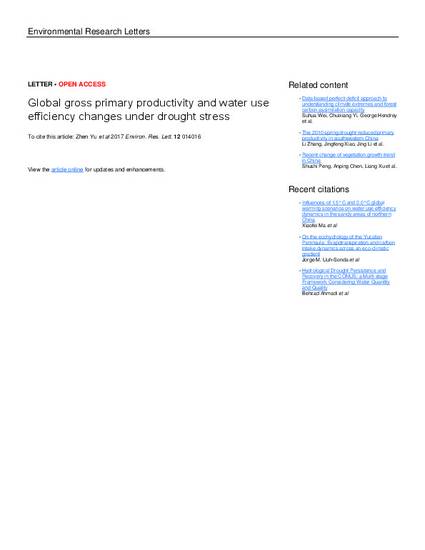
Drought can affect the structure, composition and function of terrestrial ecosystems, yet drought impacts and post-drought recovery potentials of different land cover types have not been extensively studied at a global scale. We evaluated drought impacts on gross primary productivity (GPP), evapotranspiration (ET), and water use efficiency (WUE) of different global terrestrial ecosystems, as well as the drought-resilience of each ecosystem type during the period of 2000 to 2011. Using GPP as biome vitality indicator against drought stress, we developed a model to examine ecosystem resilience represented by the length of recovery days (LRD). LRD presented an evident gradient of high (>60 days) in mid-latitude region and low (<60 days) in low (tropical area) and high (boreal area) latitude regions. As average GPP increased, the LRD showed a significantly decreasing trend, indicating readiness to recover after drought, across various land cover types (R 2 = 0.68, p < 0.0001). Moreover, zonal analysis revealed that the most dramatic reduction of the drought-induced GPP was found in the mid-latitude region of the Northern Hemisphere (48% reduction), followed by the low-latitude region of the Southern Hemisphere (13% reduction). In contrast, a slightly enhanced GPP (10%) was evident in the tropical region under drought impact. Additionally, the highest drought-induced reduction of ET was found in the Mediterranean area, followed by Africa. Water use efficiency, however, showed a pattern of decreasing in the Northern Hemisphere and increasing in the Southern Hemisphere. Drought induced reductions of WUE ranged from 0.96% to 27.67% in most of the land cover types, while the increases of WUE found in Evergreen Broadleaf Forest and savanna were about 7.09% and 9.88%, respectively. These increases of GPP and WUE detected during drought periods could either be due to water-stress induced responses or data uncertainties, which require further investigation.
Available at: http://works.bepress.com/chaoqun_lu/43/

This article is published as Yu, Z.*, J. Wang, S. Liu, J.S. Rentch, P. Sun, and C. Lu. 2017. Global gross primary productivity and water use efficiency changes under drought stress. Environmental Research Letters, 12(1), p.014016. Doi: 10.1088/1748-9326/aa5258.